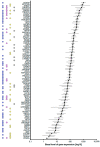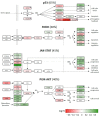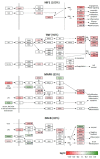In Vivo Regulation of Signal Transduction Pathways by Vitamin D Stabilizes Homeostasis of Human Immune Cells and Counteracts Molecular Stress
- PMID: 37834080
- PMCID: PMC10572664
- DOI: 10.3390/ijms241914632
In Vivo Regulation of Signal Transduction Pathways by Vitamin D Stabilizes Homeostasis of Human Immune Cells and Counteracts Molecular Stress
Abstract
Vitamin D3 is a pre-hormone that regulates hundreds of target genes and dozens of physiological functions, including calcium homeostasis and the activity of the immune system, via its metabolite 1,25-dihydroxyvitamin D3, which is a high-affinity ligand for the transcription factor vitamin D receptor. In this study, we took advantage of data from the VitDHiD vitamin D3 intervention trial (25 healthy individuals) indicating that 442 protein-coding genes were significantly (false discovery rate < 0.05) up- or downregulated in peripheral blood mononuclear cells one day after taking a vitamin D3 bolus. Since more than half of the encoded proteins had "signaling" assigned as a primary biological function, we evaluated their involvement in signal transduction cascades included in the KEGG (Kyoto Encyclopedia of Genes and Genomes) database and found 88 of the vitamin D targets contributing to 16 different pathways. Eight of the pathways show an approximately even contribution of up- and downregulated genes, suggesting that the actions of vitamin D stabilize homeostasis of the physiological processes driven by the respective signaling cascades. Interestingly, vitamin D target genes involved in the signaling pathways of hypoxia-inducible factor 1 (HIF1), tumor necrosis factor (TNF), mitogen-activated protein kinases (MAPKs) and nuclear factor κB (NFκB) are primarily downregulated. This supports the observation that the physiological role of vitamin D in healthy individuals is to tone down certain processes rather than activate them. In conclusion, under in vivo conditions, vitamin D either alleviates the homeostasis of immune cells in healthy individuals or counteracts molecular responses to oxygen deprivation (HIF1), microbe infection (TNF), growth stimulation (MAPKs) and inflammation (NFκB).
Keywords: HIF1; MAPK; NFκB; TNF; immune cells; signal transduction; vitamin D; vitamin D target genes.
Conflict of interest statement
The authors declare no conflict of interest.
Figures





Similar articles
-
In vivo vitamin D target genes interconnect key signaling pathways of innate immunity.PLoS One. 2024 Jul 23;19(7):e0306426. doi: 10.1371/journal.pone.0306426. eCollection 2024. PLoS One. 2024. PMID: 39042613 Free PMC article.
-
Relevance of vitamin D receptor target genes for monitoring the vitamin D responsiveness of primary human cells.PLoS One. 2015 Apr 13;10(4):e0124339. doi: 10.1371/journal.pone.0124339. eCollection 2015. PLoS One. 2015. PMID: 25875760 Free PMC article.
-
Dissecting high from low responders in a vitamin D3 intervention study.J Steroid Biochem Mol Biol. 2015 Apr;148:275-82. doi: 10.1016/j.jsbmb.2014.11.012. Epub 2014 Nov 13. J Steroid Biochem Mol Biol. 2015. PMID: 25448738
-
A kinetic overview of the receptors involved in 1,25-dihydroxyvitamin D3 and 24,25-dihydroxyvitamin D3 signaling: a systems biology approach.Crit Rev Eukaryot Gene Expr. 2009;19(3):181-96. doi: 10.1615/critreveukargeneexpr.v19.i3.20. Crit Rev Eukaryot Gene Expr. 2009. PMID: 19883364 Review.
-
An update on vitamin D signaling and cancer.Semin Cancer Biol. 2022 Feb;79:217-230. doi: 10.1016/j.semcancer.2020.05.018. Epub 2020 May 30. Semin Cancer Biol. 2022. PMID: 32485310 Review.
Cited by
-
Discordant Health Implications and Molecular Mechanisms of Vitamin D in Clinical and Preclinical Studies of Prostate Cancer: A Critical Appraisal of the Literature Data.Int J Mol Sci. 2024 May 13;25(10):5286. doi: 10.3390/ijms25105286. Int J Mol Sci. 2024. PMID: 38791324 Free PMC article. Review.
-
Transcriptomic profiling of immune modulation induced by vitamin D3 in the VitDPAS and VitDHiD cohort studies.Sci Rep. 2025 May 19;15(1):17334. doi: 10.1038/s41598-025-02495-w. Sci Rep. 2025. PMID: 40389645 Free PMC article. Clinical Trial.
-
Beyond skin deep: exploring the complex molecular mechanisms and holistic management strategies of vitiligo.Arch Dermatol Res. 2025 Apr 8;317(1):685. doi: 10.1007/s00403-025-04162-6. Arch Dermatol Res. 2025. PMID: 40198440 Review.
-
Vitamin D Alleviates Heavy Metal-Induced Cytotoxic Effects on Human Bone Osteoblasts Via the Induction of Bioenergetic Disruption, Oxidative Stress, and Apoptosis.Biol Trace Elem Res. 2025 Apr;203(4):2420-2434. doi: 10.1007/s12011-024-04337-8. Epub 2024 Sep 5. Biol Trace Elem Res. 2025. PMID: 39235540 Free PMC article.
-
Editorial of Special Issue "The Role of Vitamin D in Human Health and Diseases 3.0".Int J Mol Sci. 2024 Jun 29;25(13):7170. doi: 10.3390/ijms25137170. Int J Mol Sci. 2024. PMID: 39000277 Free PMC article.
References
MeSH terms
Substances
Grants and funding
LinkOut - more resources
Full Text Sources
Medical

